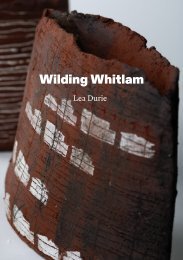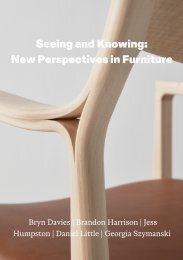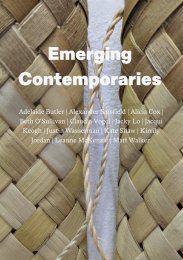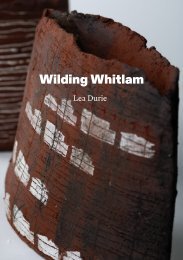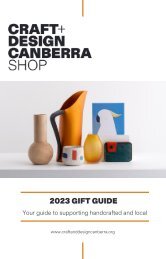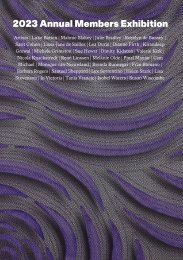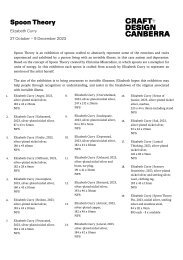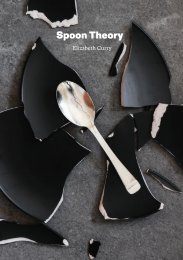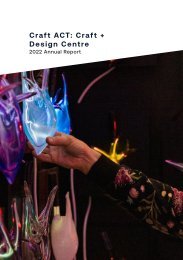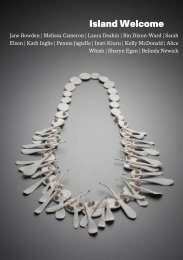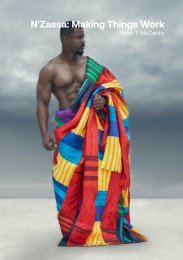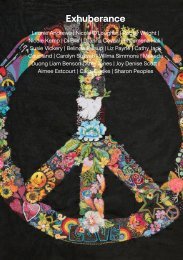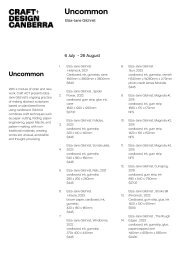Create successful ePaper yourself
Turn your PDF publications into a flip-book with our unique Google optimized e-Paper software.
<strong>Tension</strong>[s] <strong>2020</strong><br />
<strong>Tamworth</strong><br />
<strong>Textile</strong><br />
<strong>Triennial</strong><br />
Craft ACT: Craft + Design Centre
Craft ACT: Craft + Design Centre is supported by the<br />
ACT Government, the Visual Arts and Craft Strategy –<br />
an initiative of the Australian State and Territory<br />
Governments, and the Australia Council for the Arts – the<br />
Australian Government’s arts funding and advisory body.<br />
Craft ACT: Craft + Design Centre<br />
Tues–Fri 10am–5pm<br />
Saturdays 12–4pm<br />
Level 1, North Building, 180 London Circuit,<br />
Canberra ACT Australia<br />
+61 2 6262 9333<br />
www.craftact.org.au<br />
This exhibition has been developed by <strong>Tamworth</strong> Regional<br />
Gallery and is supported by the Visions regional touring<br />
program, an Australian Government program aiming to<br />
improve access to cultural material for all Australians.
<strong>Tension</strong>[s] <strong>2020</strong><br />
<strong>Tamworth</strong> <strong>Textile</strong><br />
<strong>Triennial</strong><br />
Soraya Abidin | Gillian Bencke | Julie Briggs and Kelly Leonard | Armando Chant | Georgia<br />
Chapman | Linda Erceg | Anne Ferran | Dianne Firth | Sai-Wai Foo | Tina Fox | Erica Gray | Elisa<br />
Markes-Young | Julie Montgarrett | Deborah Prior | Margarita Sampson | Mark Smith and Dell<br />
Stewart | Jane Théau | Tjanpi Desert Weavers | Yinarr Maramali<br />
Craft ACT: Craft + Design Centre<br />
24 March - 14 May 2022<br />
3
4
5
<strong>Tamworth</strong> <strong>Textile</strong> <strong>Triennial</strong><br />
Performance, Interaction and Material Futures<br />
Exhibition statement<br />
20/20 Vision is the standard notation<br />
used to indicate perfect vision. It bases<br />
its declaration of ‘perfect’ on only one<br />
thing: sharpness of vision when standing<br />
approximately six metres from an eye<br />
chart. Meanwhile, other worthwhile<br />
attributes are ignored – such as peripheral<br />
awareness, eye coordination, depth<br />
perception, focusing ability and colour<br />
vision.<br />
The saying ‘hindsight is 20/20’ suggests<br />
that the distance afforded by time enables<br />
us to better understand the past and<br />
that, by extension, hindsight might assist<br />
us to make better decisions about our<br />
future. But does this reflection take into<br />
consideration the diversity of perspectives<br />
required to really learn from the past?<br />
If there is one thing that hindsight has<br />
taught us, it is the danger of drawing<br />
meaning from only one perspective.<br />
future of people and place through textile<br />
as a material and human experience<br />
as materiality. By exploring other<br />
perspectives through the metaphor of<br />
tension, we ask:<br />
How could textiles consider people and<br />
place in developing new installation ideas?<br />
How might textiles collaborate with<br />
other interactive mediums to offer new<br />
perspectives?<br />
How can we articulate complex narratives<br />
through engaging textiles in performance?<br />
I hope that, through <strong>Tension</strong>[s] <strong>2020</strong>,<br />
the materiality of our combined working<br />
practices and perspectives can be realised<br />
beyond the scope of a rather parochial,<br />
one-dimensional, 20/20 view.<br />
- Curator Vic McEwan.<br />
<strong>Tension</strong>[s] <strong>2020</strong> acknowledges that<br />
the world has long been a place under<br />
various tension[s], both harmonious<br />
and dissonant. In order to bear witness<br />
to, contribute to and respond to these<br />
tensions, the triennial will focus on the<br />
Image: <strong>Tension</strong>[s] <strong>2020</strong> - <strong>Tamworth</strong> <strong>Textile</strong>s<br />
<strong>Triennial</strong>. Photo: Courtesy of the <strong>Tamworth</strong><br />
Regional Gallery<br />
7
8
9
Soraya Abidin<br />
Biography<br />
Soraya Abidin is a Sydney <strong>Textile</strong>s based<br />
artist, whose works aim to materialise the<br />
in-between spaces within the bi-cultural<br />
binary. Resonating with the tensions<br />
that exist in this realm, Soraya uses<br />
vintage Asian silks to address cultural<br />
misconceptions often experienced by<br />
bi-cultural people. At the same time, for<br />
Soraya, this is a space where there are no<br />
rules to be broken and cultural boundaries<br />
can be traversed. Identifying as bi-cultural<br />
herself, Abidin’s works are inspired by her<br />
experience of being in-between both her<br />
English and Malay heritages.<br />
The work, Guardians of Wellbeing,<br />
was created from a mix of Asian silks,<br />
peranakan glass beads, vintage hemp,<br />
raffia and Swiss straw. This two-faced bird<br />
is described by the artist as a shamanic<br />
headdress worn by a Bomoh, or Malay<br />
spiritual healer.<br />
Image: Guardians of Wellbeing, <strong>2020</strong>, Soraya<br />
Abidin, mixed Asian silks, peranakan glass<br />
beads, vintage hemp, raffia and Swiss straw.<br />
Photo: Courtesy of the artist<br />
11
Gillian Bencke<br />
Biography<br />
Gillian Bencke is an artist based in<br />
Newcastle, NSW.<br />
She works in photography, sculpture,<br />
installation and fibre.<br />
Gillian has a degree in Communication<br />
Studies at the University of Newcastle<br />
and also studied Photomedia at the<br />
Manchester Metropolitan University, UK.<br />
Her early practice was in photo media and<br />
included a small run of self published<br />
artist books. She later went on to study<br />
digital media at TAFE in Newcastle<br />
and produced work in digitally drawn<br />
animations.<br />
In 2004 while living and working in Paris,<br />
Gillian began to use found fabrics to<br />
create small sculpture works and has been<br />
exploring form in this medium ever since.<br />
Image: Gillian Bencke, A Case, <strong>2020</strong>. Photo:<br />
Courtesy of the artist.<br />
13
Julie Briggs & Kelly Leonard<br />
Biography<br />
Julie Briggs is known for working in poetry<br />
and art of many forms. Her work has been<br />
seen across the nation, with a recent work<br />
being displayed as a part of the Sunflower<br />
Collection Exhibition in Kandos. Now<br />
her latest work, Curation of Shadows, a<br />
collaboration with Kelly Leonard is proudly<br />
being displayed at Craft ACT.<br />
Kelly Leonard is an artist based in Broken<br />
Hill, NSW. As a teenager, Kelly was taught<br />
weaving by a second-generation Bauhaus<br />
weaver, Marcella Hempel, in Wagga<br />
Wagga, NSW.<br />
considerations in how she makes work<br />
and how work is shown to an audience.<br />
Kelly views weaving as an open-ended<br />
world making practice though which new<br />
patterns can emerge.<br />
Kelly walks on Wilyakali Country, part of<br />
the Barkindji Nation. She acknowledges<br />
that sovereignty was never ceded, what<br />
always was, always will be Aboriginal land.<br />
Since reactivating her practice in 2017,<br />
Kelly has been making work responding<br />
to the sight, sound, smell and feel of the<br />
environment, where she places woven<br />
artworks in conversation with Place, to<br />
activate new meanings and relationships.<br />
Her work is always informed from her<br />
perspective as a regional/remote artist.<br />
Kelly believes that struggles for social<br />
justice and environmentalism cannot<br />
be separated from each other and are<br />
inextricably woven together. Themes such<br />
as trust, the importance of relationships,<br />
different evaluations of time, risk<br />
taking,and the ethics of care are important<br />
Image: Julie Briggs & Kelly Leonard, Curation of<br />
Shadows, <strong>2020</strong>. Photo: Courtesy of the artist<br />
15
Armando Chant<br />
Biography<br />
As an artist, my focus is on creating work<br />
that sits in-between image and surface,<br />
facilitating a sense of visual, material and<br />
experiential transformation. Through an<br />
expanded approach to the physical and<br />
gestural act of drawing the work explores<br />
the oscillation in-between embodiment<br />
and disembodiment where the interrelationships<br />
between the drawn gesture,<br />
image and surface cross through and<br />
between sites of process.<br />
The inter-relationship between creative<br />
act and visual residue is investigated<br />
by working within an inter-disciplinary<br />
and open context, including drawing,<br />
photography, and textile techniques<br />
to evoke and materialise an sense of<br />
atmospheric presence.<br />
the image/artefact is seen not as a final<br />
outcome but part of a visual and material<br />
landscape that is in a constant state of<br />
emergence and dissolution, evolving in<br />
response to the physical act of drawing,<br />
and the ethereal trace left behind<br />
I have participated in exhibitions that<br />
reflect this expansive and explorative<br />
approach, held in London, Florence,<br />
Melbourne and Sydney.<br />
As an academic, I’ve worked as a lecturer<br />
across degree and Masters programs at<br />
leading universities in London, Sri Lanka<br />
and Australia.<br />
The practice thereby opens up a dialogue<br />
for the visual image to be re-framed or<br />
re-presented within an ephemeral and<br />
transient context across site, surface<br />
and screen, be it image, artefact or space<br />
and contribute to alternative ways of<br />
experiencing, and seeing, both image and<br />
surface where one does not take priority<br />
over the other but become a hybrid form<br />
of experience. Through this exploration<br />
Image: Armando Chant, Topographical<br />
Reflections Day (detail), <strong>2020</strong>. Photo: Courtesy<br />
of Craft ACT<br />
17
Georgia Chapman<br />
Biography<br />
Georgia Chapman’s Vixen label was much<br />
loved for more than twenty years. Now<br />
after a break to be with her young family,<br />
Georgia is bringing back her signature<br />
prints in selected products. It is the start<br />
of the Georgia Chapman label: the same<br />
design aesthetic, the same emphasis on<br />
quality, with more one-of-a-kind pieces<br />
and limited edition collections.<br />
Georgia has exhibited her work widely, and<br />
her designs feature in the National Gallery<br />
of Victoria and the Powerhouse Museum<br />
collections.<br />
Georgia’s style is to reinvent traditional<br />
motifs and patterns and combine prints<br />
in unexpected ways. She creates pieces<br />
with timeless simplicity, function and<br />
beauty. Her passion is for design, colour,<br />
craftsmanship and the handmade.<br />
Vixen Australia began in 1992, a fashion<br />
and homewares label that used all original<br />
fabrics. Printed crepe de chine, georgette,<br />
velvet devoré and a full range of silks in<br />
rich colours and textures quickly became<br />
Georgia’s trademark.<br />
For twenty years, Vixen was sold through<br />
retail outlets across Australia, Asia, and<br />
London. The Vixen flagship store in Fitzroy<br />
opened in 2007.<br />
Image: Georgia Chapman, My place, <strong>2020</strong>.<br />
Photo: Courtesy of the artist<br />
19
Linda Erceg<br />
Biography<br />
Dr Linda Erceg is a multidisciplinary artist<br />
and lecturer at the School of Creative<br />
Arts and Media at University of Tasmania<br />
in Hobart. Her creative practice spans a<br />
range of mediums, including photography,<br />
video, and installation.<br />
In recent works, Linda creates sculptural<br />
objects and large-scale installations that<br />
explore the connection between stitched<br />
artefacts, living systems and patterning.<br />
Using a range of recycled and repurposed<br />
plastics, her work is a timely exploration<br />
of the impact of anthropogenic change<br />
and the imagining of future ecologies. Her<br />
artwork has been exhibited nationally and<br />
internationally with support from Australia<br />
Council, Arts Victoria and Arts Tasmania.<br />
Image: Linda Erceg, Biomorph, <strong>2020</strong>, mixed<br />
plastics. Photo: Courtesy of the artist.<br />
21
Anne Ferran<br />
Biography<br />
Anne Ferran is an artist whose work<br />
questions representations of femininity<br />
and history, particularly the legacy of<br />
colonial histories. Her feminist and<br />
philosophical approach to photography<br />
in the 1980s and 1990s reframed<br />
the medium as not only a means of<br />
documentation but a form of cultural<br />
mediation, with its own history and<br />
blind spots. She has worked in analog<br />
and digital photography, installation,<br />
video, photobooks, and performance to<br />
address absences and erasures at sites<br />
of historical significance in New South<br />
Wales, Tasmania, and Western Australia.<br />
Ferran received a Bachelor of Arts from<br />
Sydney University, attended Mitchell<br />
College of Advanced Education (now<br />
Charles Sturt University), and received<br />
a Bachelor of Visual Arts degree from<br />
Sydney College of the Arts in 1985 and a<br />
postgraduate diploma in 1987. In 1994 she<br />
completed an MFA at the College of Fine<br />
Arts, University of New South Wales. She<br />
is an honorary fellow at the University of<br />
Wollongong.<br />
Image: Anne Ferran, Field Haunter from Birdlike<br />
Series, <strong>2020</strong>. Photo: Courtesy of the artist<br />
23
Dianne Firth<br />
Biography<br />
Although educated as a landscape<br />
architect Dianne had early training with<br />
textiles at Newcastle Technical College<br />
and Glasgow Art School and was involved<br />
with textiles for fashion, theatre costume<br />
and interiors. She discovered quilting after<br />
seeing a collection of Amish quilts at the<br />
National Gallery of Victoria in the early<br />
1980s and undertaking a masterclass with<br />
American art quilter Nancy Crow.<br />
Her works have been selected for<br />
major juried international and national<br />
exhibitions, publications and for public and<br />
private collections. Since 2001 she has<br />
been one of six artists in the Canberrabased<br />
tACTile group with the objective of<br />
expanding the boundaries of the art quilt<br />
and mounting exhibitions to travel.<br />
Firth is Adjunct Associate Professor in<br />
the Faculty of Arts and Design at the<br />
University of Canberra. She holds a<br />
Bachelor of Landscape Architecture, a<br />
PhD, is a Fellow of the Australian Institute<br />
of Landscape Architects and advises<br />
the ACT Government on issues related<br />
to landscape heritage, trees, and urban<br />
design.<br />
Image: Blown by the wind, Dianne Firth, <strong>2020</strong>.<br />
Photo: Courtesy of the artist.<br />
25
Sai-Wai Foo<br />
Biography<br />
Sai-Wai Foo is an emerging artist and<br />
graduate of RMIT, Melbourne. Her practice<br />
focuses on the manipulation and folding<br />
of cut paper to produce sculptural volume<br />
and structure from a 2-dimensional<br />
medium.Her works combine organic paper<br />
with other pieces of collected ephemera to<br />
create vignettes and still points in time.<br />
Exploring the use and repurposing of<br />
discarded unwanted items, Foo aims to<br />
seek out a new aesthetic. The materials<br />
used are discarded but once treasured<br />
items that have outlived their usefulness<br />
or owners. She subverts their use through<br />
repurposing and with the additional of<br />
the artisanal, to imbue an item with a new<br />
value. It is a way to question how things<br />
are used in our over-curated and insatiable<br />
consumer society.<br />
These interwoven elements marry the<br />
past and present create an object that<br />
transports the viewer into another realm;<br />
an intersection of the nostalgic and the<br />
contemporary.<br />
Image: Sai-Wai Foo, Children of the Sun, <strong>2020</strong>.<br />
Photo: Courtesy of the artist<br />
27
Tina Fox<br />
Biography<br />
Tina Fox trained as an architect at<br />
The Bartlett School and University of<br />
Westminster in London and went on to<br />
complete an MA Art in Architecture at the<br />
University of East London.<br />
After working for over 10 years in<br />
architecture and interior design, Fox<br />
moved to Sydney in 2011 and expanded<br />
her private practice into visual and public<br />
art.<br />
Her current work explores hand crafted<br />
techniques to reflect on digital printing and<br />
manufacturing and the future of craft in<br />
the modern age.<br />
She has exhibited large public textile<br />
sculptures in Sydney for Vivid, The North<br />
Sydney Art Prize, Harbour Sculpture,<br />
Sawmillers Sculpture Prize and The<br />
Sydney Architecture Festival and is<br />
currently one of the resident artists at the<br />
TWT Creative Precinct in St Leonards.<br />
Image: Tina Fox, Crochet Machine, <strong>2020</strong>. Photo:<br />
Courtesy of artist<br />
29
Erica Gray<br />
Biography<br />
Erica’s lif.e.quatic series is inspired by<br />
the natural aquatic environment and<br />
the creatures within. Her interpretation<br />
of the complexity of structures, vivid<br />
colours and intricate patterning observed<br />
in a variety of marine creatures as well<br />
as a reference to man’s influence over<br />
the environment. This meshing of<br />
aquatic and terrestrial influences forms<br />
a symbolic representation of how coral<br />
and its surrounding ecosystems, once<br />
autonomous, must now cling to us in<br />
the hopes of maintaining their continued<br />
existence.<br />
as well as North Qld’s sculpture Festival -<br />
The Strand Ephemera in 2011, 2013, 2015,<br />
2019 and was joint winner of the Artistic<br />
Award of Excellence in 2011 and the 1st<br />
prize winner of the Award for Artistic<br />
Excellence in 2017.<br />
Erica’s work has been a finalist in<br />
numerous painting and sculpture prizes,<br />
among them she was a semi-finalist in<br />
the Doug Moran National Portrait Prize in<br />
both 2019 and 2013, she was a finalist in<br />
the 2015 Hurford Hardwood Portrait Prize<br />
as well as the Glencore Perceval Portrait<br />
Prize in 2012, 2016, 2018 and <strong>2020</strong>. With<br />
her sculptural work she has been a finalist<br />
in the <strong>Tamworth</strong> <strong>Textile</strong> <strong>Triennial</strong> in 2014<br />
and <strong>2020</strong>, a finalist in the Gold Coast Swell<br />
Sculpture Festival 2010, 2011, 2014, 2016<br />
Image: Erica Gray, Immortal coil, <strong>2020</strong>. Photo:<br />
Courtesy of the artist<br />
31
Elisa Markes-Young<br />
Biography<br />
Elisa Markes-Young was born on New<br />
Year’s Eve 1964 in Gorlice, Poland. In 1981,<br />
she moved to Germany with her family,<br />
then Western Australia in early 2002.<br />
With her cross-cultural biography, Elisa’s<br />
identity is punctuated by the question of<br />
how Polish or German she really is. It is<br />
also very much defined by the feeling of<br />
being caught between two worlds.<br />
The excitement of living in a foreign<br />
country is accompanied by an intense<br />
feeling of displacement. Being a stranger<br />
and ‘different’, having to master another<br />
language and the mentality of a new place<br />
creates a feeling of insignificance and<br />
inadequacy. Trying to navigate between<br />
the Polish origins, German influences and<br />
Australian surroundings, Elisa recognizes<br />
that self-reflection is crucial to her identity:<br />
It is a reflection on the variations of her<br />
‘handed-down’ identity.<br />
Image: Hugs and Kisses, Elisa Markes-Young,<br />
<strong>2020</strong>. Photo: Courtesy of the artist<br />
33
Julie Montgarrett<br />
Biography<br />
Julie Montgarrett is a textile artist,<br />
curator and former lecturer whose<br />
practice includes over 100 solo and group<br />
exhibitions, site specific installations,<br />
public art commissions and ground<br />
breaking community-based arts projects<br />
in Australia and internationally. Her works<br />
are represented in major Art Gallery and<br />
Museum collections in Australia and<br />
internationally. Her main interests are<br />
in the areas of drawing and embroidery<br />
to extend the conceptual and spatial<br />
possibilities of textile as narrative<br />
questioning dominant Australian histories;<br />
to explore doubt and fragility via visual<br />
narratives in complex installations.<br />
Image: Julie Montgarrett, Grim Harvest<br />
Plundered Wealth and Squandered Plenty, <strong>2020</strong>.<br />
Photo Museum and Galleries of New South<br />
Wales<br />
35
Deborah Prior<br />
Biography<br />
Deborah Prior’s art practice navigates the<br />
complexities and pleasures of having and<br />
being a body, via craft practices including<br />
knitting, stitching and embroidery<br />
Using salvaged, stained, and damaged<br />
material(s) from the domestic sphere, she<br />
crafts soft sculptures, installations, and<br />
performances that explore ideas of bodily<br />
agency, disgust & desire, and the personal<br />
and social histories of domestic work.<br />
Most recently, Prior has been investigating<br />
the shared visual language of body<br />
fragments in medical illustration/<br />
modelling and religious iconography,<br />
positioning her textile pieces as profane<br />
relics to invite conversation around the<br />
contested knowledges, histories, and<br />
mythologies of female corporeality.<br />
Based in Adelaide, Prior has been crafting<br />
strange anatomies for thirteen years.<br />
She completed her PhD in Visual Arts<br />
at the University of South Australia in<br />
2014. In 2016 she spent several months<br />
on residency in Italy as the recipient of<br />
the Helpmann Academy British School in<br />
Rome Residency, which continues to be a<br />
rich vein of inspiration for her practice.<br />
Image: Deborah Prior, <strong>2020</strong>, Easter in the<br />
Anthropocene. Photo: Courtesy of the artist<br />
37
Margarita Sampson<br />
Biography<br />
Margarita Sampson works predominantly<br />
in soft sculpture & contemporary jewellery.<br />
Her work is strongly influenced by her<br />
Norfolk Island background, referencing<br />
natural forms, patterns & textures, in<br />
particular underwater lifeforms.<br />
“I’m interested in the idea of colonisation,<br />
growth, opportunistic expansion, the<br />
organic versus the inorganic, taking over<br />
spaces and recontextualising them. I<br />
don’t like to be too specific with the forms<br />
in my work, I like them to be suggestive<br />
enough of any number of possibilities<br />
so that the viewer brings their own story<br />
and imagination to the party.... then the<br />
work starts to resonate, through that<br />
conversation. If a work answers, its own<br />
questions it’s dead.”<br />
Image: Margaret Sampson, Olympia, <strong>2020</strong>.<br />
Photo: Courtesy of the artist<br />
39
Mark Smith and Dell Stewart<br />
Biography<br />
Working across painting, ceramics, mixed<br />
media, video and soft sculpture, Mark<br />
Smith’s primarily figurative works are<br />
concerned with how the physicality of<br />
the body relates to human nature and the<br />
human condition. Smith considers the<br />
body a nonnegotiable starting point for<br />
existence, using the primitive vessel to<br />
explore the truly distinctive characteristics<br />
of being human. Within this framework<br />
Smith addresses the experiences and<br />
complexities of the individual and of<br />
humanity as a whole, as well as examining<br />
the ‘language’ of a subtle movement or<br />
position. Working purely from feeling or<br />
emotion rather than a model or image,<br />
Smith’s works possess an intrinsic nature<br />
or indispensable quality that imbues them<br />
with a deep sense of character.<br />
Dell Stewart’s work combines various<br />
processes often regarded as belonging<br />
to the world of craft (ceramics, textiles,<br />
animation) with a deeply embedded<br />
personal history. These practices and<br />
references assemble in immersive<br />
environments, often offering no clue<br />
to the boundary between the artwork<br />
and the space it occupies. A personal,<br />
subjective symbology pervades the work<br />
making each iteration another chapter in a<br />
narrative of a life lived doing.<br />
Mark and Dell came together in artistic<br />
collaboration to create an artwork<br />
especially for the <strong>Tamworth</strong> <strong>Textile</strong><br />
<strong>Triennial</strong> <strong>Tension</strong>[s] <strong>2020</strong>. The resulting<br />
Love mobile was created in the spirit<br />
of learning and working together, and<br />
celebrating the complications and<br />
tensions implicit in any relationship. Love<br />
mobile uses soft hand-stitched forms,<br />
oversized stuffed letters and sculptural<br />
fabric elements linked through a complex<br />
web of handmade ropes to represent<br />
connections, networks and relationships<br />
The work takes the form of an oversized<br />
mobile; continually moving and changing,<br />
it embodies the role of chance in<br />
encounters, understandings and the<br />
formation of connections between people.<br />
Image: Love Mobile, <strong>2020</strong>, Mark Smith and<br />
Dell Stewart, ice-dyed cotton, polyester fill and<br />
trims, cotton rope, dimensions variable. Photo:<br />
Courtesy of <strong>Tamworth</strong> Regional Gallery<br />
41
Jane Théau<br />
Biography<br />
Jane Théau develops sculptural<br />
installations, such as her on-going series<br />
of large-scale embroidered Threadworks.<br />
Jane said, ‘Given my conceptual concern<br />
with sustainability, I enjoy the fact that<br />
these textile works use very little material,<br />
and weigh but a few grams, even as<br />
room-sized installations… I particularly<br />
appreciate the metaphorical qualities<br />
of textiles: the ravelling and unravelling,<br />
the weaving and fraying, the mending<br />
and rending.’ Jane has a Master of Art<br />
(Sculpture) from the College of Fine Arts<br />
(COFA), University of NSW, a Master<br />
of International Affairs from Columbia<br />
University and a Bachelor of Applied<br />
Science from the University of Technology<br />
Sydney. She has actively exhibited in solo<br />
and group exhibitions since 2009, was a<br />
finalist in the 2011 Powerhouse Museum<br />
International Lace Award, and curated<br />
2015’s Y Fibre, an exhibition of male textile<br />
art at the Ewart Gallery in Sydney.<br />
Image: Jane Théau, Anca (detail), <strong>2020</strong>. Photo:<br />
Courtesy of the artist<br />
43
Tjanpi Desert Weavers | Dianne Ungukalpi Golding,<br />
Judith Yinyika Chambers, Joyce James, Charlotte<br />
Golding<br />
Biography<br />
Tjanpi Desert Weavers is a social<br />
enterprise of the Ngaanyatjarra<br />
Pitjantjatjara Yankunytjatjara (NPY)<br />
Women’s Council, working with women<br />
in the remote Central and Western<br />
desert regions who earn an income from<br />
contemporary fibre art. Tjanpi (meaning<br />
grass in Pitjantjatjara language) represents<br />
over 400 Anangu/Yarnangu women artists<br />
from 26 remote communities on the NPY<br />
lands.<br />
Tjanpi artists use native grasses to make<br />
spectacular contemporary fibre art,<br />
weaving beautiful baskets and sculptures<br />
and displaying endless creativity and<br />
inventiveness. Originally developing from<br />
the traditional practice of making manguri<br />
rings, working with fibre in this way has<br />
become a fundamental part of Central and<br />
Western desert culture.<br />
desert weaving phenomenon and have<br />
fuelled Tjanpi’s rich history of collaborative<br />
practice.<br />
Tjanpi has a public gallery in Alice<br />
Springs showcasing baskets, sculptures,<br />
jewellery, books, merchandise and more,<br />
while Tjanpi artworks are also found<br />
at stockists around the country. Tjanpi<br />
regularly exhibits work in national galleries<br />
and facilitates commissions for public<br />
institutions.<br />
Tjanpi embodies the energies and rhythms<br />
of Country, culture and community. The<br />
shared stories, skills and experiences<br />
of this wide-reaching network of<br />
mothers, daughters, aunties, sisters and<br />
grandmothers form the bloodline of the<br />
Image: L-R: Joyce James, Charlotte Golding,<br />
Dianne Golding with Pitja Nyawa Kulila Pampula<br />
in Warakurna, WA. Photo: Courtesy of the artists<br />
45
Yinarr Maramali Gomeroi Community<br />
Biography<br />
Yinarr Maramali (YML) is a Gomeroi<br />
women’s business based on Country<br />
(<strong>Tamworth</strong>, NSW), who support the<br />
wellbeing of their Community and<br />
Country through the continuation of<br />
their ancestral weaving culture. Bringing<br />
together generations of yinarrgal (women)<br />
and miyaygal (girls), who connect and<br />
share their stories through hand-woven<br />
creations and artworks. Using only natural<br />
materials collected by hand from Country<br />
and ethically sourced materials that are<br />
gentle on the environment.<br />
Yinarr Maramali is 100 percent owned and<br />
operated by local Gomeroi Yinarr. Every<br />
weaving purchase supports the YML<br />
Weavers and their cultural community<br />
programs.<br />
Image: Yinarr Maramali, Weaving Warrabah,<br />
2019. Lomandra, water vine. Photo: Miranda<br />
Heckenberg<br />
47
List of works<br />
1-10 Sai-Wai Foo<br />
Children of the Sun, <strong>2020</strong><br />
All works on half scale<br />
mannequins<br />
$12,000<br />
5 Sai-Wai Foo<br />
Tang Suit, <strong>2020</strong><br />
Metallic brocade, trim,<br />
tassel, metal chain, resin<br />
bead, satin, elastic, cotton<br />
webbing, lead weight,<br />
thread<br />
1 Sai-Wai Foo<br />
Dragon Lady, <strong>2020</strong><br />
Brocade, metallic, frog buttons,<br />
metallic fabric, thread<br />
6 Sai-Wai Foo<br />
Blosson Woman, <strong>2020</strong><br />
Metallic brocade, frog<br />
buttons, glass beads,<br />
vintage trims, gold work,<br />
tassels, paint, metal studs,<br />
lead weight, thread<br />
2 Sai-Wai Foo<br />
Suzy Wong, <strong>2020</strong><br />
Lurex knit, metallic fabric, cotton<br />
webbing, thread, (A nod to<br />
Modern Cheongsam or Qi Pao<br />
in the 1960 film World of Suzie<br />
Wong)<br />
3 Sai-Wai Foo<br />
Crazy Rich Asian, <strong>2020</strong><br />
Gold fabric, vinyl, chain, satin,<br />
snap buttons, heavy card,<br />
adhesive, woven trim, tassel<br />
thread<br />
7 Sai-Wai Foo<br />
Dowager, <strong>2020</strong><br />
Brocade, metallic, frog<br />
buttons, metallic fabric,<br />
sandalwood fan, metal<br />
chain, lead weight, thread<br />
8 Sai-Wai Foo<br />
Ideal Student, <strong>2020</strong><br />
Cotton fabric, metallic<br />
fabric, cotton webbing,<br />
tassels, wadding, snap<br />
button, plastic beads,<br />
thread<br />
4 Sai-Wai Foo<br />
Old Guard, <strong>2020</strong><br />
Gold fabric, metal buckle, thread<br />
9 Sai-Wai Foo<br />
Tiger Mother, <strong>2020</strong><br />
Organza, metallic, trim,<br />
gold work, embroidery,<br />
applique, metal thread,<br />
elastic, thread<br />
48
10 Sai-Wai Foo<br />
Qing Style Dress, <strong>2020</strong><br />
Brocade, metallic, frog buttons,<br />
metallic fabric, thread<br />
11 Yinarr Maramali Gomeroi<br />
Community<br />
Weaving Warrabah (Short Neck<br />
Turtle), 2019<br />
Lomandra and Water vine<br />
NFS<br />
15 Armando Chant<br />
Topographic Reflections Day<br />
(white), <strong>2020</strong><br />
Screen printed silk, digital<br />
printed silk and wool, silk<br />
hand embroidery, needle<br />
felting<br />
$15,000<br />
16 Margarita Sampson,<br />
Olympia, <strong>2020</strong><br />
Video tape, textiles, wood,<br />
steel<br />
$28,000<br />
12 Mark Smith with Dell<br />
Stewart | Arts Projects Australia<br />
& Australian Tapestry Workshop<br />
Love mobile, <strong>2020</strong><br />
Ice-dyed cotton, polyester fill and<br />
trims, cotton rope, eucalyptus<br />
branches<br />
NFS<br />
17 Elisa Markes-Young<br />
Comforter #02, <strong>2020</strong><br />
Tulle, Chiffon, organza, wool,<br />
paper, gold foil, sequins, bead<br />
and thread<br />
$3000 (#18-20)<br />
13 Armando Chant<br />
Topographic Reflections film,<br />
<strong>2020</strong><br />
Aerial film x 2 Night runs 9: 43<br />
min & Day runs 11:33 mins<br />
NFS<br />
18 Elisa Markes-Young<br />
Hugs and Kisses, <strong>2020</strong><br />
Faux fur, calico, wool, silk,<br />
sequins, beads, cotton and<br />
polyester thread<br />
14 Armando Chant<br />
Topographic Reflections Day<br />
(black), <strong>2020</strong><br />
Screen printed silk, digital<br />
printed silk and wool, silk hand<br />
embroidery, needle felting<br />
$5,000<br />
19 Elisa Markes-Young<br />
The Original Place #09/5, 2018<br />
Fabric, paper, hand<br />
embroidery, sequins, beads,<br />
faux fur, gold foil and thread<br />
49
List of works<br />
20 Elisa Markes-Young,<br />
Memory of a Memory edition 2/5,<br />
<strong>2020</strong><br />
Hand finished artist book<br />
25 Julie Briggs & Kelly<br />
Leonard<br />
Curation of Shadows, <strong>2020</strong><br />
Linen, burnt remnants and video<br />
$10,000<br />
21 Georgia Chapman<br />
My place, <strong>2020</strong><br />
Acrylic paint and foil hand<br />
painted details, Digital<br />
sublimation print on canvas<br />
$5,000<br />
22 Julie Montgarrett<br />
Grim Harvest: plundered wealth<br />
and squandered plenty, <strong>2020</strong><br />
Screenprinted silk organza,<br />
fabric remnants, found blankets,<br />
lace Kantha stitched, small<br />
cushions and ceramic bowls<br />
$18,000<br />
23 Erica Gray<br />
Immortal coil, <strong>2020</strong><br />
Cotton, polyester, pearl beads<br />
& 3D printed bones, plastic on<br />
mount<br />
$5,000<br />
26 Tjanpi Desert Weavers<br />
| Dianne Ungukalpi Golding,<br />
Judith Yinyika Chambers, Joyce<br />
James, Charlotte Golding<br />
Pitja Nyawa Kulila Pampula (Come<br />
Look Listen Touch), <strong>2020</strong>, Tjanpi<br />
(grass), raffia, hemp yarn, steel<br />
and wire<br />
$15,000<br />
27 Tina Fox<br />
Crochet Machine, <strong>2020</strong><br />
Aluminium, linen, thread,<br />
recycled polyester, LCD monitor,<br />
wood, rubber foam<br />
$8,000<br />
28 Jane Théau<br />
Anca, <strong>2020</strong><br />
Video<br />
$2,000<br />
24 Anne Ferran<br />
Plains Wanderer from Bird- like<br />
Series, <strong>2020</strong><br />
Pigment print on canvas.<br />
Performer Kirsten Packham<br />
NFS<br />
29 Jane Théau<br />
Anca (bojande), <strong>2020</strong><br />
Tarlatan, silk organza, thread<br />
and wire<br />
$4,000<br />
50
30 Jane Théau<br />
Anca (vridande), <strong>2020</strong><br />
Tarlatan, silk organza, thread<br />
and wire<br />
$4,000<br />
35 Linda Erceg<br />
Biomorph, <strong>2020</strong><br />
Mixed plastics<br />
POA<br />
31 Jane Théau<br />
Anca (I flykt), <strong>2020</strong><br />
Tarlatan, silk organza, thread and<br />
wire and projector<br />
$4,000<br />
36 Dianne Firth<br />
Blown by the Wind #4, <strong>2020</strong><br />
Netting, material stitching<br />
$6,000<br />
32 Soraya Abidin<br />
Guardians of Wellbeing, <strong>2020</strong><br />
Mixed Asian silks, Peranakan<br />
glass beads, vintage hemp, raffia<br />
and Swiss straw<br />
$5,000<br />
33 Deborah Prior<br />
Easter in the Anthropocene<br />
(squatter blanket #1), <strong>2020</strong><br />
Archive of plant labels, found<br />
woollen blankets (Onkaparinga<br />
and Laconia brand) yarn and<br />
sellotape<br />
NFS<br />
34 Gillian Bencke<br />
A case, <strong>2020</strong><br />
Linen, wool, cotton, nylon, felt,<br />
silk, sequins, beads, pins, copper,<br />
brass, bronze polymer clay and<br />
clay<br />
$25,000<br />
51


![Tension[s] 2020 Tamworth Textile Triennial Catalogue](https://img.yumpu.com/66621372/1/500x640/tensions-2020-tamworth-textile-triennial-catalogue.jpg)

